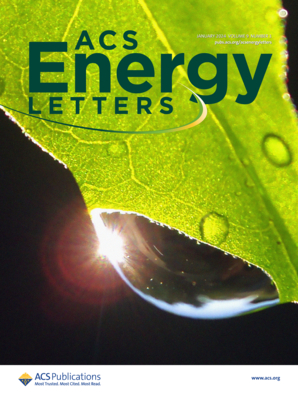用于全固态锂离子电池的超离子导体Li7-x (GeSi)(1-x)/2SbxS5I银汞酸锂硫化物
IF 18.2
1区 材料科学
Q1 CHEMISTRY, PHYSICAL
引用次数: 0
摘要
基于Li6PS5I的固态电解质(ses)在全固态电池(assb)中表现出良好的界面兼容性,但它们仍然受到离子电导率有限的影响。本文通过Ge、Si和Sb取代P,制备了一种超离子导体锂银晶硫化物Li7-x (GeSi)(1-x)/2SbxS5I,增加了Li6PS5I的构型熵。该方法提高了锂离子的含量和阴离子位点的无序性,导致锂离子迁移的活化能低至0.17 eV,从而获得了高的冷压离子电导率,达到12.7 mS cm-1,热压离子电导率达到创纪录的32.2 mS cm-1。当加入Li3InCl6作为阴极和中间层时,LiNi0.8Co0.1Mn0.1O2@Li3InCl6|Li3InCl6|Li20/3(GeSiSb)1/ 3s5i |Li-In assb在0.1 C时具有219 mAh g-1的高容量,在550次循环后具有135 mAh g-1的显著容量,在1 C下保留84.4%。我们的assb在- 20至60°C范围内稳定循环,并且在100 mg cm-2的超高阴极负载下运行良好。这些发现推动了硫化物sbs在高性能和宽温assb中的应用。本文章由计算机程序翻译,如有差异,请以英文原文为准。

A Superionic Conductor Lithium Argyrodite Sulfide of Li7–x(GeSi)(1–x)/2SbxS5I toward All-Solid-State Lithium-Ion Batteries
Li6PS5I based solid-state electrolytes (SSEs) show promising interface compatibility for all-solid-state batteries (ASSBs), but they still suffer from limited ionic conductivity. Herein, a superionic conductor lithium argyrodite sulfide, Li7–x(GeSi)(1–x)/2SbxS5I, was developed through multi-cation substitution of Ge, Si, and Sb for P, increasing configurational entropy of the Li6PS5I. This approach enhanced Li+ content and anion site disorder, leading to a low activation energy of 0.17 eV for Li+ migration, and consequently a high cold-pressed ionic conductivity of 12.7 mS cm–1, and a record value of 32.2 mS cm–1 after hot-pressing. When incorporating Li3InCl6 as the catholyte and interlayer, the LiNi0.8Co0.1Mn0.1O2@Li3InCl6|Li3InCl6|Li20/3(GeSiSb)1/3S5I|Li-In ASSBs exhibited a high capacity of 219 mAh g–1 at 0.1 C, and a notable capacity of 135 mAh g–1 with 84.4% retention at 1 C after 550 cycles. Our ASSBs demonstrated stable cycling across −20 to 60 °C and operated well at an ultrahigh cathode loading of 100 mg cm–2. These findings advance sulfide SSEs for high-performance and wide-temperature ASSBs.
求助全文
通过发布文献求助,成功后即可免费获取论文全文。
去求助
来源期刊

ACS Energy Letters
Energy-Renewable Energy, Sustainability and the Environment
CiteScore
31.20
自引率
5.00%
发文量
469
审稿时长
1 months
期刊介绍:
ACS Energy Letters is a monthly journal that publishes papers reporting new scientific advances in energy research. The journal focuses on topics that are of interest to scientists working in the fundamental and applied sciences. Rapid publication is a central criterion for acceptance, and the journal is known for its quick publication times, with an average of 4-6 weeks from submission to web publication in As Soon As Publishable format.
ACS Energy Letters is ranked as the number one journal in the Web of Science Electrochemistry category. It also ranks within the top 10 journals for Physical Chemistry, Energy & Fuels, and Nanoscience & Nanotechnology.
The journal offers several types of articles, including Letters, Energy Express, Perspectives, Reviews, Editorials, Viewpoints and Energy Focus. Additionally, authors have the option to submit videos that summarize or support the information presented in a Perspective or Review article, which can be highlighted on the journal's website. ACS Energy Letters is abstracted and indexed in Chemical Abstracts Service/SciFinder, EBSCO-summon, PubMed, Web of Science, Scopus and Portico.
 求助内容:
求助内容: 应助结果提醒方式:
应助结果提醒方式:


